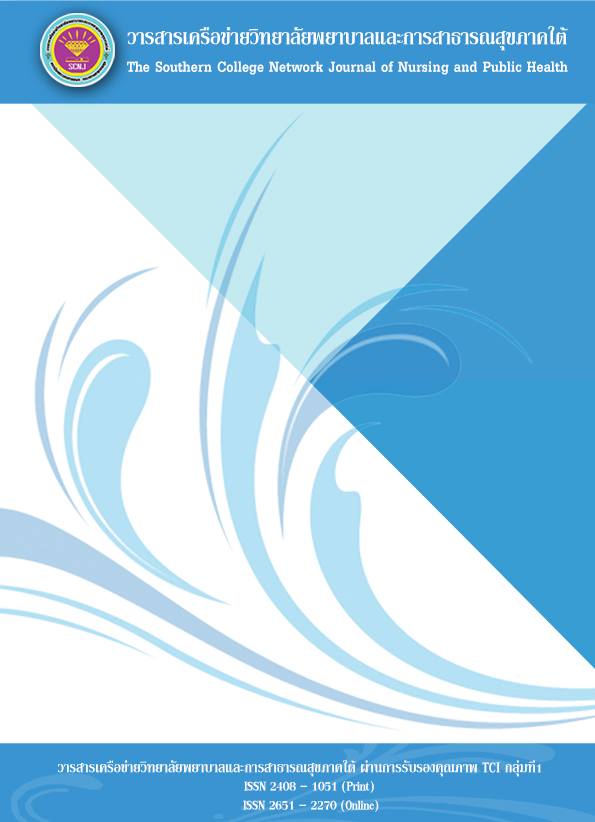ผลของโปรแกรมสนับสนุนการควบคุมน้ำหนักของนักเรียนที่มีภาวะโภชนาการเกิน ในโรงเรียนประถมศึกษาเขตเทศบาล จังหวัดนครศรีธรรมราช
คำสำคัญ:
การสนับสนุนการควบคุมน้ำหนัก, ภาวะโภชนาการเกิน, นักเรียนบทคัดย่อ
การวิจัยกึ่งทดลองครั้งนี้มีวัตถุประสงค์เพื่อศึกษาผลของโปรแกรมสนับสนุนการควบคุมน้ำหนักของนักเรียนที่มีภาวะโภชนาการเกินในโรงเรียนประถมศึกษาเขตเทศบาล จังหวัดนครศรีธรรมราช กลุ่มตัวอย่างเป็นนักเรียนระดับประถมศึกษาชั้นปีที่ 4-6 ที่มีภาวะโภชนาการระดับท้วมและเริ่มอ้วนจาก 2 โรงเรียน จำนวน 72 คน จากการสุ่มแบบหลายขั้นตอน แบ่งเป็นกลุ่มทดลองและกลุ่มควบคุมจำนวนกลุ่มละ 36 คน กลุ่มทดลองได้รับการสนับสนุนการควบคุมน้ำหนักโดยใช้แนวคิดการสนับสนุนทางสังคม จากพยาบาล เพื่อน ครู และผู้ปกครอง ช่วยสนับสนุนการควบคุมอาหารและเพิ่มกิจกรรมทางกายเป็นเวลา 12 สัปดาห์ กลุ่มควบคุมได้รับการดูแลแนวทางปกติ เครื่องมือที่ใช้ในการวิจัยประกอบด้วยโปรแกรมการสนับสนุนการควบคุมน้ำหนัก แบบประเมินพลังงานจากการบริโภคอาหารใน 1 วัน และแบบประเมินพลังงานจากกิจกรรมทางกายใน 1 วัน ประเมินน้ำหนักตัวก่อนและหลังการทดลอง วิเคราะห์ข้อมูลโดยใช้สถิติเชิงพรรณนา การทดสอบไคสแควร์ และสถิติการทดสอบค่าที ผลการวิจัยพบว่า
1. กลุ่มทดลองมีค่าเฉลี่ยน้ำหนักตัวลดลงจาก 50.81 (SD=8.05) เป็น 45.96 (SD=7.56) kgs. อย่างมีนัยสำคัญทางสถิติ (p<.05)
2. กลุ่มควบคุมมีค่าเฉลี่ยน้ำหนักตัวเพิ่มขึ้นจาก 49.44 (SD=6.84) เป็น 53.04 (SD=6.58) kgs. อย่างมีนัยสำคัญทางสถิติ (p<.05) และเมื่อเปรียบเทียบระหว่างกลุ่มทดลองกับกลุ่มควบคุมพบว่าน้ำหนักตัวมีความแตกต่างกัน 7.08 kgs. อย่างมีนัยสำคัญทางสถิติ (p<.05)
เอกสารอ้างอิง
Bean, M. K., Wilson, D. B., Thornton, L. M., Kelly, N., & Mazzeo, S. E. (2012). Dietary Intake in a Randomized-Controlled Pilot of NOURISH: A Parent Intervention for Overweight Children. Preventive Medicine, 55(3), 224-227.
Bhadrakom, C. (2014). Economic Analysis of Overnutrition in Thailand. (Doctoral PH.D. Dissertation, University of Reading, Thailand).
Braet, C., O'Malley, G., Weghuber, D., Vania, A., Erhardt, E., Nowicka, P., & Ardelt-Gattinger, E. (2014). The Assessment of Eating Behaviour in Children Who are Obese: a Psychological Approach. A Position Paper from the European Childhood Obesity Group. Obesity Facts, 7(3), 153-164.
Buapian, A., Hansakul, A., Tornee, S., & Bunchonhattakit, P. (2014). The Developing Guidelines of Helth Promotion Activities for Body Weight Controlling Among Over Nutrition Students. Journal of Faculty of Physical Education, 17(1), 141-151. (in Thai)
Butte, N. F. (2015). 1.3. 2 Energy Requirements of Infants, Children and Adolescents. Pediatric Nutrition in Practice, 113, 34-40.
Cao, Z. J., Wang, S. M., & Chen, Y. (2015). A Randomized Trial of Multiple Interventions for Childhood Obesity in China. American Journal of Preventive Medicine, 48(5), 552-560.
Chaisri, J., Klungtumneim, K., & Buajarean, H. (2014). Clinical Nursing Practice Guideline for Management of Obesity in Children: the Synthesis of Thesis. Journal of The Royal Thai Army Nurses, 15(2), 360-367. (in Thai)
Contreras, M., Zelaya Blandon, E., Persson, L. A., & Ekstrom, E. C. (2016). Consumption of Highly Processed Snacks, Sugar-Sweetened Beverages and Child Feeding Practices in a Rural Area of Nicaragua. Maternal & Child Nutrition, 12(1), 164-176.
Cunningham, S. A., Kramer, M. R., & Narayan, K. V. (2014). Incidence of Childhood Obesity in the United States. New England Journal of Medicine, 370(5), 403-411.
Danielsen, Y. S., Stormark, K. M., Nordhus, I. H., Maehle, M., Sand, L., Ekornas, B., et al. (2012). Factors Associated with Low Self-Esteem in Children with Overweight. Obesity Facts, 5(5), 722-733.
Department of Family Medicine and Primary Care Services. (2015). Annual Report 2015. Nakhon Si Thammarat: Thung Yai Hospital. (in Thai)
Fagundez, L. J. M., Torres, A. R., Sanchez, M. E. G., de Torres Aured, M. L., Rodrigo, C. P., & Rocamora, J. A. I. (2015). Historia Dietetica: Metodologia Yaplicaciones. Nutricion Hospitalaria, 31(s03), 57-61.
Fakhouri, T. H., Kit, B. K., Carroll, M. D., Flegal, K. M., & Ogden, C. L. (2014). Obesity in Older Adults in the United States. Handbook of Obesity--Volume 1: Epidemiology, Etiology, and Physiopathology, 1, 67.
Finkler, E., Heymsfield, S. B., & St-Onge, M. P. (2012). Rate of Weight Loss Can be Predicted by Patient Characteristics and Intervention Strategies. Journal of the Academy of Nutrition and Dietetics, 112(1), 75-80.
House, J. S., Umberson, D., & Landis, K. R. (1988). Structures and Processes of Social Support. Annual Review of Sociology, 293-318.
Khunudom, P., Powwattana, A., Lagampan, S., & Nanthamongkolchai, S. (2012). An Application of Health Protection Motivation Theory for Child Rearing in Mothers of Obese Children. Journal of Public Health Nursing, 26(3), 31-44. (in Thai)
Ling, J., Robbins, L. B., Resnicow, K., & Bakhoya, M. (2014). Social Support and Peer Norms Scales for Physical Activity in Adolescents. American Journal of Health Behavior, 38(6), 881-889.
Mosuwan, L., & Chittchang, U. (2012) Guideline to Nutrition Indicators and Related Diseases. Bangkok: The Printing House of the Veterans Administration under the Royal Patronage. (in Thai)
Nawsuwan, K., Kitrungrote, T., Chotiban, P., Rodniam, J., Bua-ngam, J., & Nakaramontri, S. (2013). Modification of Health Behavior of Elementary School Students with Overweight By the Participation of Community Health Parties. Nursing Journal of the Ministry of Public Health, 23(2), 44-54. (in Thai)
Nutrition Bureau Ministry of Public Health. (1999). Guideline to the use of Reference Criteria High Weight to Assess the Growth of Thai Children. Bangkok: The Printing House of the Veterans Administration under the Royal Patronage. (in Thai)
Nutrition Bureau Ministry of Public Health. (2015). Annual Report 2014. Nonthaburi: Public Health. (in Thai)
Polit, D., & Hungler, B. (1987). Nursing Research: Strategies for a Natural Sociology. (3rd ed.).
Poti, J. M., Duffey, K. J., & Popkin, B. M. (2014). The Association of Fast Food Consumption with Poor Dietary Outcomes and Obesity among Children: Is it the Fast Food or the Remainder of the Diet?. The American journal of clinical nutrition, 99(1), 162-171.
Printz, C. (2014). Extreme Obesity May Shorten Life Expectancy up to 14 years. Cancer, 120(23), 3591-3591.
Rattanasakornchai, S. (2015). Factor Affecting Food Consumption Behavior of Mathayom Suksa 3 Students In Muang Chumphon Distric Chumphon Province. FDA Journal, 22(1), 61-72. (in Thai)
Salimin, N., Elumalia, G., Shahri, M. I., & Subramaniam, G. (2015). The Effectiveness of 8 Weeks Physical Activity Program among Obese Students. Procedia-Social and Behavioral Sciences, 195, 1246-1254.
Sangngeon, P., & Quanboonchan, R. (2015). The Effects of Health Program Management on Weight and Body Fat Percentage of Overweigh Elementary School Students. An Online Journal of Education, 10(1), 82-93. (in Thai)
Setiawan, B., Karimah, I., & Khomsan, A. (2014). Physical Fitness in Normal and Overweight Elementary School Children. Pakistan Journal of Nutrition, 13(1), 22-27.
Shang, L., Wang, J., O’Loughlin, J., Trembly, A., Mathieu, M. E., Henderson, M., & Gray-Donald, K. (2015). Screen Time is Associated with Dietary Intake in Overweight Canadian Children. Preventive Medicine Reports, 2(1), 265-269.
Shen, B., Centeio, E., Garn, A., Martin, J., Kulik, N., Somers, C., & McCaughtry, N. (2016). Parental Social Support, Perceived Competence and Enjoyment in School Physical Activity. Journal of Sport and Health Science, 19(2), 1-7.
Sunpakaew, W., Sanasuttipun, W., Sangperm, P., & Likitmaskul, S. (2014). The Relationships Between Social Support, Selected Factors and Food Consumption Behaviors in Adolescents at risk for Type 2 Diabetes. Kuakarun Journal of Nursing, 21(Supplement), 186-204.
ดาวน์โหลด
เผยแพร่แล้ว
ฉบับ
ประเภทบทความ
สัญญาอนุญาต
1. บทความหรือข้อคิดเห็นใด ๆ ที่ปรากฏในวารสารเครือข่าย วิทยาลัยพยาบาลและการสาธารณสุขภาคใต้ ที่เป็นวรรณกรรมของผู้เขียน บรรณาธิการหรือเครือข่ายวิทยาลัยพยาบาลและวิทยาลัยการสาธารณสุขภาคใต้ ไม่จำเป็นต้องเห็นด้วย
2. บทความที่ได้รับการตีพิมพ์ถือเป็นลิขสิทธิ์ของ วารสารเครือข่ายวิทยาลัยพยาบาลและการสาธารณสุขภาคใต้








